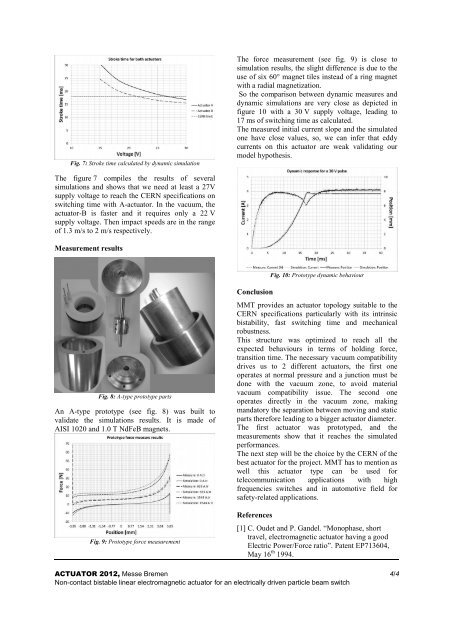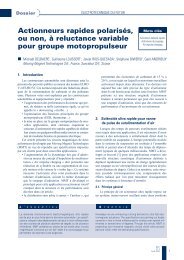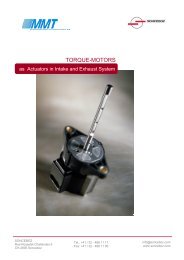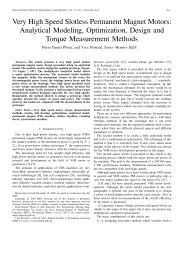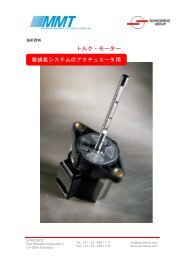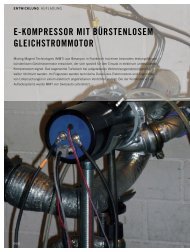Actuator 2012 - Moving Magnet Technologies
Actuator 2012 - Moving Magnet Technologies
Actuator 2012 - Moving Magnet Technologies
You also want an ePaper? Increase the reach of your titles
YUMPU automatically turns print PDFs into web optimized ePapers that Google loves.
Fig. 7: Stroke time calculated by dynamic simulationThe force measurement (see fig. 9) is close tosimulation results, the slight difference is due to theuse of six 60° magnet tiles instead of a ring magnetwith a radial magnetization.So the comparison between dynamic measures anddynamic simulations are very close as depicted infigure 10 with a 30 V supply voltage, leading to17 ms of switching time as calculated.The measured initial current slope and the simulatedone have close values, so, we can infer that eddycurrents on this actuator are weak validating ourmodel hypothesis.The figure 7 compiles the results of severalsimulations and shows that we need at least a 27Vsupply voltage to reach the CERN specifications onswitching time with A-actuator. In the vacuum, theactuator-B is faster and it requires only a 22 Vsupply voltage. Then impact speeds are in the rangeof 1.3 m/s to 2 m/s respectively.Measurement resultsFig. 10: Prototype dynamic behaviourFig. 8: A-type prototype partsAn A-type prototype (see fig. 8) was built tovalidate the simulations results. It is made ofAISI 1020 and 1.0 T NdFeB magnets.Fig. 9: Prototype force measurementConclusionMMT provides an actuator topology suitable to theCERN specifications particularly with its intrinsicbistability, fast switching time and mechanicalrobustness.This structure was optimized to reach all theexpected behaviours in terms of holding force,transition time. The necessary vacuum compatibilitydrives us to 2 different actuators, the first oneoperates at normal pressure and a junction must bedone with the vacuum zone, to avoid materialvacuum compatibility issue. The second oneoperates directly in the vacuum zone, makingmandatory the separation between moving and staticparts therefore leading to a bigger actuator diameter.The first actuator was prototyped, and themeasurements show that it reaches the simulatedperformances.The next step will be the choice by the CERN of thebest actuator for the project. MMT has to mention aswell this actuator type can be used fortelecommunication applications with highfrequencies switches and in automotive field forsafety-related applications.References[1] C. Oudet and P. Gandel. “Monophase, shorttravel, electromagnetic actuator having a goodElectric Power/Force ratio”. Patent EP713604,May 16 th 1994.ACTUATOR <strong>2012</strong>, Messe Bremen 4/4Non-contact bistable linear electromagnetic actuator for an electrically driven particle beam switch


